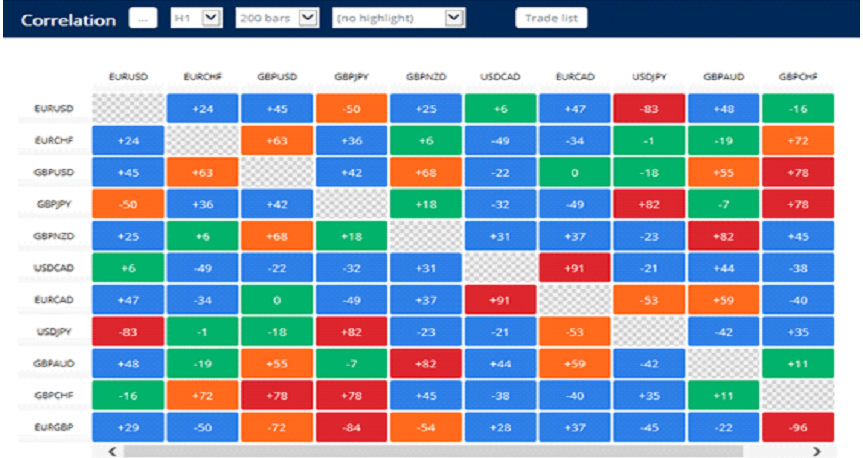One aspect of the Forex market that distinguishes it from other financial markets is the concept of currency pairs. When you open a currency position, you gain access to two different currencies. This creates many exciting possibilities, including the ability to measure the strength of one currency against another.
However, it makes it difficult to measure the effectiveness of a single coin. Consider the Euro / US Dollar (EURUSD) currency pair. If it rallied strongly in one day, is it because the euro is doing well or the dollar is doing poorly?
This article will discuss the solution to this problem: an online indicator called “Monetary Force Meter”.available for download in MetaTrader 5 Supreme Edition! If you want to calculate the strength of the different currencies you trade, you can download this free MetaTrader plugin by clicking on the banner below.
This Forex indicator shows which currencies are strong and which are weak at any given time. Using a useful money force meter, you will have another tool at your disposal that will allow you to become a profitable trader.
What is a monetary force meter?
So what is a monetary force meter or a monetary force indicator?
Simply put, a coin strength meter is a visual aid that shows which currencies are currently strong and which are weak. Currency strength indicators apply the exchange rates of various currency pairs to obtain each currency’s aggregate comparable strength. Simple counters cannot use weights, while more advanced counters can use their values. They can even combine other indicators with measuring the strength of currency to provide trading signals.
Calculate the strength of the US dollar; the currency strength meter will calculate the strength of all pairs that contain the US dollar (for example, USDJPY, EURUSD, GBPUSD, AUDUSD, etc.) and then combine these calculations to determine the overall result for the US dollar.
A lesser-known but more comprehensive metric is the broad US dollar index, which uses a wider variety of currencies. They both work the same way. They estimate the dollar’s strength by combining two-sided exchange rates into one number and then applying weights to the included currencies. The value used to the overall index is the business weight derived from the business data. In particular, this is the share of merchandise imports in annual bilateral trade with the United States.
- Read More Free Forex FFx Universal Strength Meter

Problems with Currency Strength Meters
Unfortunately, there are several problems when it comes to indicators of currency strength, mostly when they are poorly coded. If a monetary force meter does not provide accurate values for a monetary force indicator, it is of little use regardless of its other functions. With outdated money force meters, operators can face:
- MetaTrader 4 (MT4) freezes
- PC freezes
- Stuttering
- Circular saw signs
- Memory loss
- The CPU runs continuously at 100%.
Some products may even provide data that deviates from the original concept of currency strength. Some apply anti-aliasing filters, such as moving averages, and others apply other filters (such as RSI and MACD). By adding filters in addition to showing the strength of a coin, traders can detect false trading signals and can enter bad trades, resulting in a losing streak.
Instead, the best way to measure the strength of a currency is through its correlation. Suppose the Forex correlation matrix has been properly coded using the latest technology. In that case, it is unlikely to cause any of the problems mentioned above, while still having the same advantages as a monetary strength meter.
Forex Correlation Matrix – Measurement of Real Currency Strength
Over the years, Forex strength meters have naturally evolved into currency correlation matrices that can provide more sophisticated and accurate information. Correlation Forex, like other correlations, indicates a correlation between two currency pairs.
From a financial point of view, “correlation” is a numerical measure of the relationship between two variables (in this case, the variables are currency pairs). The range of the correlation coefficient is -1 to +1. A correlation of +1 indicates that two currency pairs will move in the same direction. A correlation of -1 indicates that two currency pairs will move in the opposite direction 100%. Finally, a correlation of zero means that the relationship between a currency pair is completely arbitrary
When two currency pairs are strongly associated with each other, we say they have a high correlation.
When pairs move in the same direction, they have a positive correlation, and when they move in the opposite direction, we see that they have a negative correlation. A perfect correlation occurs when pairs move in the same direction, which is extremely rare. We say that the correlation is high when the pairs move almost in the same direction.
- Read More FX CORRELATION EA – [Cost $99]- For FREE
How can you use currency correlation to calculate currency strength?
Since currencies are traded in pairs (for example, EURUSD is the euro paired with the US dollar), we can use correlations to measure individual currencies’ strength.
For example, if EURGBP and GBPUSD correlate -91, this means that they have a negative correlation; these pairs are likely to move in opposite directions, so, likely, two long trades (or two short trades) on these pairs will help each reverse Another way out.
In the first pair, the quoted currency is the British pound (this means that extended operations imply a strengthening of the euro against the British pound). In the second pair, the British pound is the base currency (which means that long trades imply a strengthening of the pound against the US dollar). This means that a long EURGBP trade suggests a weakening of the GBP, and a long GBPUSD trade suggests a strengthening GBP.
It comes to the strength of the currency since there is such a high correlation between the two pairs, we can assume that the British pound (the common currency between the pairs) is the one that drives these movements and, therefore, the pound. The sterling is the strongest currency in this example.
Benefits of using a Real Currency Strength Meter
Using the Currency Correlation Matrix as an indicator of Forex strength offers several benefits, including its simplicity, usefulness as a short-term indicator, the ability to eliminate double exposure and unnecessary hedging, and the ability to point out high-risk trading and the fact that it is available for free.
A useful short-term indicator of currency strength
Professional traders often use FX strength meters as short-term indicators. They are useful as a quick reference on which currencies are rising, but are more of a snapshot of current strength than anything else, making them useful for immediate trading decisions (or testing signals provided by other indicators).
Monetary force meters are simple.
The main advantage of the Forex Strength Meter is its ease of understanding. This is especially attractive to novice traders – you don’t need to be a Forex market expert because you can only look at a simple graphical representation and see which currencies perform well or poorly.
MetaTrader Supreme Edition is a free MetaTrader plugin designed exclusively for traders with an Admiral Markets account. It includes an indicator package with 16 new indicators, including a Forex correlation matrix that allows you to view and compare different currency pairs in real-time.
Some other free features include a mini trading terminal, global sentiment widget, technical information, and Forex trading ideas provided by Trading Central.
Correlation matrices eliminate double exposure.
Highly correlated assets are moving in the same direction. For this reason, it is not recommended to open multiple positions with highly correlated pairs, as you are making the same trade more than once. This puts you in a very vulnerable position if the market turns against you. In Forex, if a trader is long in AUDCHF, AUDJPY, and EURJPY, he runs the risk of double exposure if they are highly correlated.
The positions mentioned above bring double exposure to the AUD and JPY, which can be detrimental to trading if the move goes in the opposite direction to the trader’s expectations.
With the Forex Correlation Matrix, you can see at a glance which currencies are correlated, which means that you can avoid taking those trades in the first place and thus avoid double exposure of a weak currency.
Forex Strength Meters Eliminate Inadvertent Hedging
If the strength of the correlation between different pairs is known in advance, the trader can avoid unnecessary hedging. For example, if there is a negative correlation between EUR / USD and USD / CHF, you will know that they are moving in different directions. So if you have long trades on both, you are more likely to win one trade and lose the other.
Again, knowing this in advance helps avoid unintentional coverage.
Monetary Force Gauges Indicate High-Risk Operations.
The correlation between different currency pairs can also indicate the level of risk of a trading strategy. For example, if we are long on EUR / USD and GBPUSD, and both pairs are positively correlated, this indicates a possible double risk for the same position if one of the currencies is strong.
It can also come about that one of the pairs indicates a strong move. At the same time, the other fluctuates, signaling traders to avoid opening trades with pairs correlated in the opposite direction. For example, if the EUR / USD is in a downtrend and the GBP / USD is fluctuating, the trader should avoid a long position on GBP / USD, which carries a higher risk of a downturn due to the possible strength of the dollar.
- Read More Forex Hedging Strategy Explained



[…] analyze the strengths (or power) of currencies about each other. To correct this problem, a free Currency Strength Meter was developed. In this article, we’ll introduce you to the […]